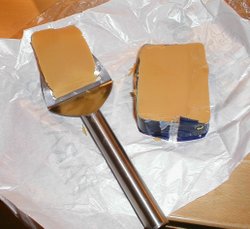Brunost

Brunost is usually sliced very thinly using a metal cheese slicer
|
|
| Alternative names |
|
|---|---|
| Type | Whey cheese |
| Place of origin | Norway |
| Region or state | Scandinavia |
| Serving temperature | As sandwich, crispbread or biscuit topping, or in sauces. |
| Main ingredients | Whey, milk and/or cream and whey |
| Variations |
|
| |
|
Brunost ("brown cheese") is a common, Norwegian name for mysost ("whey cheese"; Danish: myseost; Swedish: mesost; Finnish: meesjuusto; Icelandic: mysuostur), a family of cheese-related foods made with whey, milk, and/or cream. It is often used to just refer to the Gudbrandsdalsost ("Gudbrand Valley Cheese") type, which is the most popular variety. Brunost is primarily produced and consumed in Norway. It is regarded as one of the country's most iconic foodstuffs, and is considered an important part of Norwegian gastronomical and cultural identity and heritage.
Boiling down whey to create a soft, brown spread (such as the Norwegian prim and Swedish messmör) probably has been common in the Scandinavian countries since time immemorial. An archeological find from September 2016 in central Jutland has determined that a cheese residue on pottery from circa 650 B.C. is a type of cheese probably brunost. However, the creation of the modern, firm, fatty brunost is commonly attributed to the milkmaid Anne Hov from the Gudbrand Valley. In the second half of the 1800s, the Gudbrand Valley, a rural part of Norway, was suffering economically due to falling profits from grain and butter sales. While working at the Valseter mountain farm near Gålå in 1863 Anne Hov (sometimes named Anne Haav) came up with the idea of adding cream to the whey when boiling, and to boil it down in an iron pot until the fluid content was reduced to less than 80 percent, creating a firmer, fattier, more cheese-like product. She originally called it feitost ("fat cheese"). The name later changed into fløtemysost ("cream whey cheese"), and this variety is currently the second most popular type. The product immediately caught on, and was soon commonly produced and consumed in the area. When Anne Hov married and moved to Rusthågå farm in Sør-Fron, she started larger-scale production and invented a variety where she added goat's milk to the mix for a more pronounced taste. The local trader Ole Kongsli liked it so much he thought there might be a market for the product in the capital, Oslo. He started exporting it to his business contacts in Oslo under the name Gudbrandsdalsost ("Gudbrand Valley Cheese"), and it became so successful that it contributed significantly to the economy of the region, thus helping the Gudbrand Valley out of recession.
...
Wikipedia
